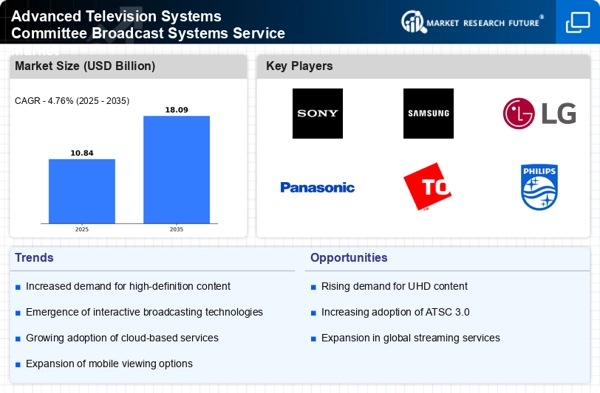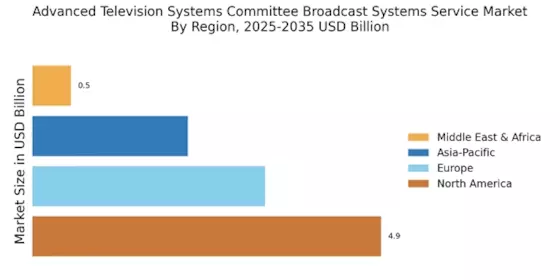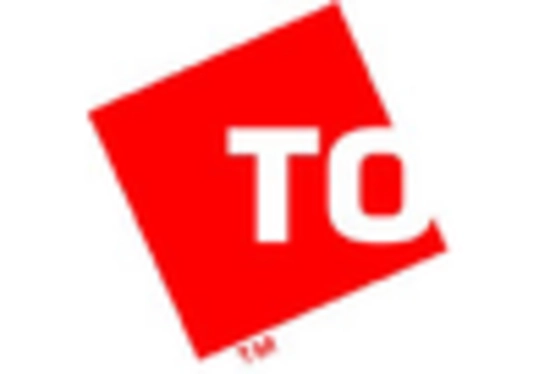Expansion of 5G Technology
The rollout of 5G technology is anticipated to significantly impact the Advanced Television Systems Committee Broadcast Systems Service Market. With its high-speed data transmission capabilities, 5G enables seamless streaming of high-definition content and enhances mobile viewing experiences. This technology facilitates the delivery of interactive and immersive content, which is becoming increasingly popular among consumers. As 5G networks expand, broadcasters are likely to leverage this technology to enhance their service offerings and reach wider audiences. The potential for 5G to transform content delivery methods suggests that the Advanced Television Systems Committee Broadcast Systems Service Market will experience substantial growth as it adapts to this new technological landscape.
Rising Demand for High-Quality Content
Consumer preferences are shifting towards high-quality content, which is a key driver for the Advanced Television Systems Committee Broadcast Systems Service Market. Viewers are increasingly seeking superior visual and audio experiences, prompting broadcasters to invest in advanced production techniques and technologies. The demand for premium content, including live sports and original programming, is expected to rise, with a projected increase in subscription-based services. This trend suggests that broadcasters must adapt to changing consumer expectations by enhancing their content offerings. As a result, the Advanced Television Systems Committee Broadcast Systems Service Market is likely to expand as companies strive to deliver high-quality content that meets the evolving needs of audiences.
Technological Advancements in Broadcasting
The Advanced Television Systems Committee Broadcast Systems Service Market is experiencing a surge in technological advancements that enhance broadcasting capabilities. Innovations such as 4K and 8K resolution, High Dynamic Range (HDR), and immersive audio formats are becoming increasingly prevalent. These technologies not only improve viewer experience but also drive demand for new broadcasting equipment and infrastructure. According to recent data, the adoption of 4K content is projected to reach 50% of all television households by 2025, indicating a robust market for advanced broadcasting solutions. As broadcasters strive to meet consumer expectations for high-quality content, the Advanced Television Systems Committee Broadcast Systems Service Market is likely to witness significant growth fueled by these technological developments.
Increased Investment in Broadcasting Infrastructure
Investment in broadcasting infrastructure is a critical driver for the Advanced Television Systems Committee Broadcast Systems Service Market. As demand for high-quality content and advanced broadcasting technologies rises, broadcasters are compelled to upgrade their infrastructure to support new capabilities. This includes investments in transmission facilities, studio equipment, and content management systems. Recent data indicates that The Advanced Television Systems Committee Broadcast Systems Service Market is projected to grow significantly, driven by the need for enhanced broadcasting services. Consequently, the Advanced Television Systems Committee Broadcast Systems Service Market is likely to benefit from these investments, as they enable broadcasters to deliver superior content and improve overall service quality.
Integration of Artificial Intelligence in Broadcasting
The integration of artificial intelligence (AI) into broadcasting processes is emerging as a transformative driver for the Advanced Television Systems Committee Broadcast Systems Service Market. AI technologies are being utilized for content creation, audience analysis, and personalized viewing experiences. For instance, AI algorithms can analyze viewer preferences and recommend tailored content, enhancing viewer engagement. Furthermore, AI-driven automation in production and distribution processes can lead to cost efficiencies and improved operational effectiveness. As broadcasters increasingly adopt AI solutions, the Advanced Television Systems Committee Broadcast Systems Service Market is poised for growth, with AI expected to play a pivotal role in shaping the future of broadcasting.


















Leave a Comment